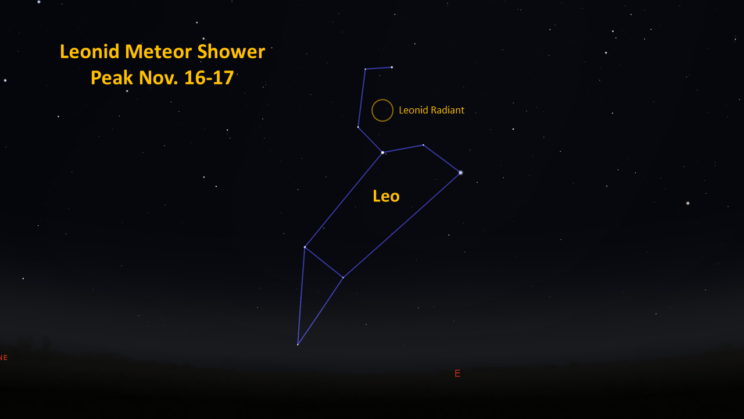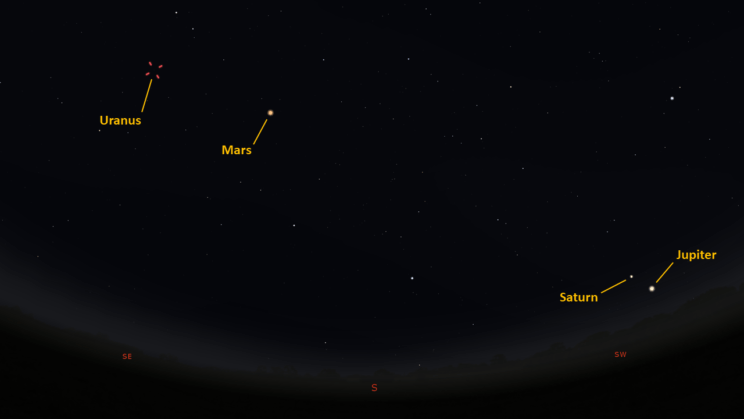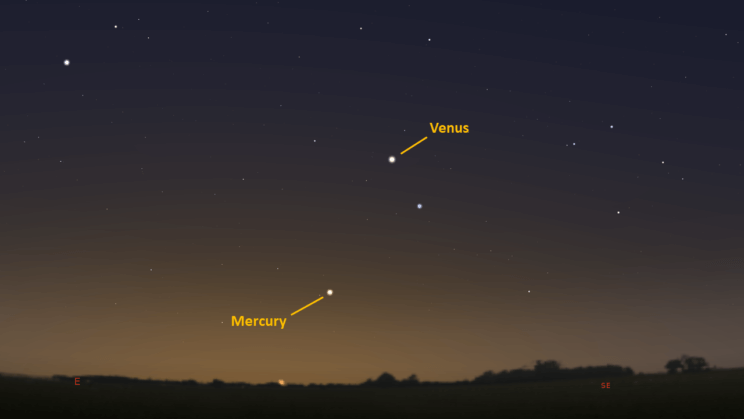This is the Saint Louis Science Center’s NIGHT SKY UPDATE for the week of Friday, November 13, 2020.
Information updated weekly or as needed.
Times given as local St. Louis time or Central Standard Time (CST). For definitions of terminology used in the night sky update, click the highlighted text.
Public Telescope Viewings
Star parties at the Saint Louis Science Center have temporarily been canceled due to recommendations from the CDC regarding COVID-19. All public telescope events are canceled until further notice. As conditions change, we will reevaluate and update this article once public observing events resume.
Observing Highlight of the Week

Location Leo and Leonid Radiant November 17 at 1:30 am
Credit: Stellarium, EG
The highlight for this week is the Leonid Meteor Shower. The Leonids occur every November as Earth passes through debris from comet 55P/Temple-Tuttle. This is a short period comet that orbits the Sun roughly every 33 years. The Leonids are famous for producing increased rates of meteors on a period of roughly 30 years. This coincides with when 55P/ Temple-Tuttle is near its perihelion. It is not new debris from the comet that produces the spikes in visibility rates but rather debris from past perihelion passes. Famously during past years with perihelion passes of 55P/Temple-Tuttle, the Leonids produced so many visible meteors they were labeled meteor storms. The cycle of these meteor storms appears to be roughly every 33 years putting the next possible storm around 2031. Unfortunately, it does not look like Earth will be passing through one of these denser debris fields until 2099. For now, most Leonid displays are expected to produce 15 meteors per hours at their peak but in years near the comet’s perihelion passage there may be displays of 100 meteors per hour. The next time this could happen would be 2031 and 2066.
The peak for the Leonids in 2020 occurs on November 16 and 17. To observe this year’s shower you will need to know when the constellation Leo becomes visible. Leo rises a little before midnight on the night of November 16. The best views will be after 1:00 a.m. when the radiant of the Leonids is found higher above the horizon. A meteor shower’s radiant is the point which the meteors appear to emanate from. It is not the only place you should look but its location determines where you will see meteors. Near midnight the radiant is just above the eastern horizon which means you will see meteors moving up from the east. As the radiant is climbs higher, meteors will be seen moving in all directions with the radiant as the apparent source.
Getting to a dark sky and time are your best bets to see meteors this week. Time is important because your eyes take about 40 minutes to adapt to the dark and visibility rates are rated in hours not minutes. If you only have a few minutes though, it is still worth poking your head outside because you could always have good luck and see a few meteors. Seeing just one meteor can be an exhilarating experience.
The Sun and Moon

The Moon as seen from the International Space Station, on July 31, 2011.
Credit: NASA
Sunrise is at 6:42 a.m. on Friday, November 13 and sunset is at 4:49 p.m. providing us with roughly 10 hours of daylight. Even after sunset, the light from the Sun will dimly illuminate our sky for about 1 hour and 30 minutes. This period is called twilight, which ends around 6:21 p.m. this week. For those with a sundial, local noon occurs around 11:45 p.m. this week.
| Day | Sunrise | Sunset |
|---|---|---|
| 2020-11-13 | 6:42 a.m. | 4:49 p.m. |
| 2020-11-14 | 6:43 a.m. | 4:48 p.m. |
| 2020-11-15 | 6:44 a.m. | 4:47 p.m. |
| 2020-11-16 | 6:45 a.m. | 4:47 p.m. |
| 2020-11-17 | 6:46 a.m. | 4:46 p.m. |
| 2020-11-18 | 6:47 a.m. | 4:45 p.m. |
| 2020-11-19 | 6:48 a.m. | 4:45 p.m. |
| 2020-11-20 | 6:49 a.m. | 4:44 p.m. |
| 2020-11-21 | 6:50 a.m. | 4:44 p.m. |
Moon
Moonrise for Friday, November 13 occurs at 4:34 a.m. and moonset will occur at 4:07 p.m. On Friday, November 13 the Moon will exhibit a waning crescent phase with 3% of the lunar disk illuminated. New moon occurs on November 14 at 11:07 p.m.
International Space Station (ISS) Observing

Visible passes of ISS from St. Louis for the week of November 13 occur during evening hours. The best passes this week occur on the evenings of November 19 and 21. Use the table below for information about these and other visible passes this week.
Catch ISS from St. Louis starting Friday, November 13
| Date | Starts | Max. altitude | Ends | |||||||
|---|---|---|---|---|---|---|---|---|---|---|
| Time | Alt. | Az. | Time | Alt. | Az. | Time | Alt. | Az. | ||
| 17 Nov | -1.7 | 18:00:05 | 10 | SSE | 18:01:55 | 15 | SE | 18:01:55 | 10 | SE |
| 18 Nov | -2.3 | 18:47:22 | 10 | SW | 18:49:26 | 35 | SW | 18:49:26 | 10 | SW |
| 19 Nov | -3.4 | 17:59:40 | 10 | SSW | 18:02:55 | 47 | SE | 18:03:52 | 10 | E |
| 20 Nov | -2.4 | 17:12:19 | 10 | S | 17:15:10 | 26 | SE | 17:18:01 | 10 | ENE |
| 20 Nov | -2 | 18:48:46 | 10 | W | 18:51:10 | 30 | WNW | 18:51:10 | 30 | WNW |
| 21 Nov | -3.2 | 18:00:37 | 10 | WSW | 18:03:55 | 54 | NW | 18:05:26 | 27 | NNE |
Magnitude (Mag): The Measure of brightness for a celestial object. The lower the value is, the brighter the object will be.
Altitude (Alt): The angle of a celestial object measured upwards from the observer’s horizon.
Azimuth (Az): The direction of a celestial object, measured clockwise from an observer’s location with north being 0°, east being 90°, south being 180° and west being 270°.
For information about ISS flyovers and other visible satellites, visit www.heavens-above.com
Detailed information regarding all unmanned exploration of our universe, missions past, present, and planned, can be found at Jet Propulsion Laboratories:
The Visible Planets

Looking South, at 8:00 pm, November 13, 2020
Credit: Stellarium, EG

Looking East, 6:00 am, November 14, 2020
Credit: Stellarium, EG
This week, five naked eye planets are visible. Jupiter and Saturn are found in the southwest once it is dark. Mars is found high in the east after sunset. Mercury and Venus can be found in the eastern sky before sunrise. About halfway through the week we will lose Mercury to the Sun’s glare.
For those tracking Jupiter and Saturn as they approach their great conjunction later this year, the two gas giants currently appear about 3.8° apart in the sky. From now until December 21, Jupiter will appear closer to Saturn each night.
Mercury
Mercury is now past greatest elongation and is now headed back into the Sun’s glare. There is still a chance to catch this elusive planet for the next 3 or 4 days. Your best bet will be to look southeast around 6:00 a.m. Mercury starts the week about 12° below Venus.
Venus
Venus rises at 3:49 a.m. and will be easily seen by 4:06 a.m. Venus remains a morning object until March 26, 2021 when it reaches superior conjunction. Since Venus has passed greatest western elongation, it is exhibiting a gibbous phase.
Mars
Currently Mars appears as a -1.7-magnitude object that will be visible in the east about 30 minutes after sunset. Mars sets by 3:42 a.m. We are still near enough to Mars that surface features are visible through telescopes. Earth is moving away from Mars which means Mars is getting fainter each night. The observing season for this apparition ends around March 10, 2021 and superior conjunction occurs on October 7, 2021.
Jupiter
Look for Jupiter in the south about 30 minutes after sunset. Jupiter will set at 8:50 p.m. Those with a telescope can enjoy views of Jupiter’s cloud features and the Great Red Spot when it is pointed towards Earth.
Saturn
Look for the ringed planet in the south about 30 minutes after sunset. Saturn sets at 9:10 p.m. For those with a telescope keep track of the orientation of Saturn’s rings. Since Saturn is tilted on its rotational axis, we cross the plane of Saturn’s ring every 13 to 15 years. We are headed towards another ring plane crossing on March 23, 2025. Over the next five years you will notice Saturn’s rings will gradually incline towards an edge on appearance.
Uranus
Uranus is not a planet we normally include in this section. Even at its dimmest, the giant planet does hover within naked eye visibility. That said, it is so close to the visible limit of the human eye it just is not reality for most of us to see Uranus without binoculars or a telescope. Uranus is just past opposition and as such, it is still easy to spot. You can find Uranus in the constellation Aries the Ram. The current magnitude for Uranus is 5.7. A finder chart for Uranus can be found here.
2020 Great Conjunction
This year the planets Jupiter and Saturn will reach conjunction. A conjunction is when two or more celestial bodies share the same right ascension. For Jupiter and Saturn this astronomical event occurs every 20 years. The conjunction occurs on December 21, 2020. You will find the two planets close together in the southwest just after sunset on this date.
Visit the James S. McDonnell Planetarium for more information on what’s up!
Night Sky Update: November 13-November 21, 2020






